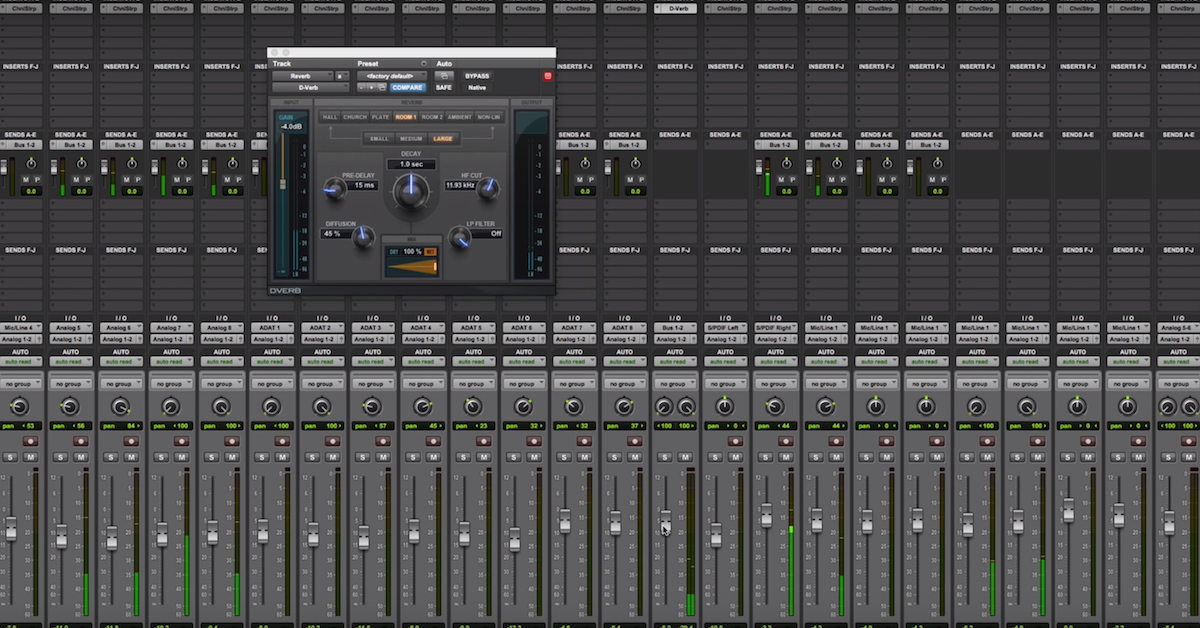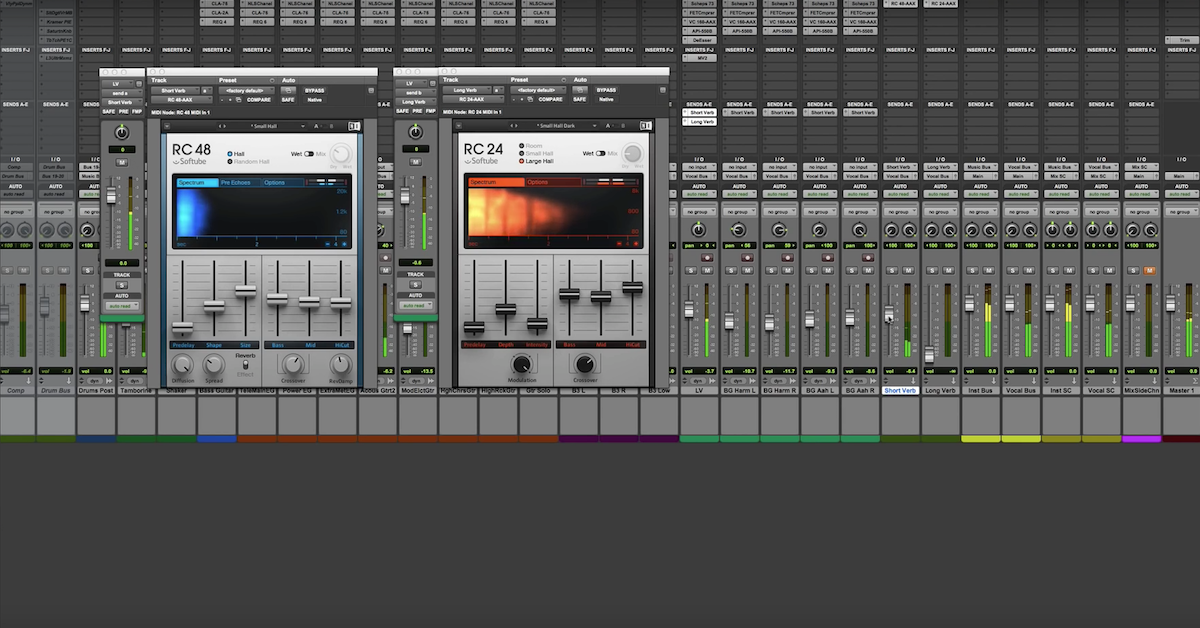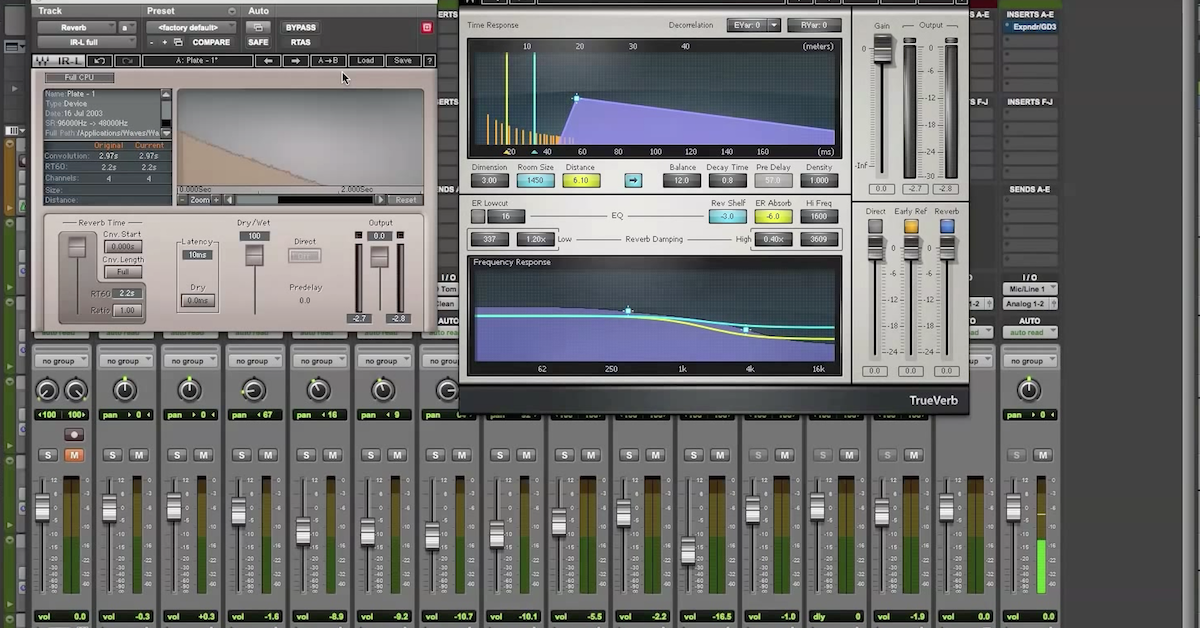How to Use Multiple Types of Reverb in a Mix
Article Content
Is it okay to use multiple types of reverb in a mix?
My answer is yes, probably. Thank you for reading this article.
Jokes aside, I’ll see this question come up every once in a while, and I understand there may be people on both sides of the argument. Before we dive deep into my reasoning, let’s quickly cover what the different types of reverbs are, and how I may typically use them when producing and mixing.
The Spaces (Chambers, Halls, Rooms)
While you could technically separate these into 3 separate categories, I’ll bundle them together for the sake of simplicity. Chambers, Halls and Rooms are each types of physical spaces that offer their own reflective qualities.
Chambers — Popular recording studios of yesteryear used chambers, which are reflective spaces that have been wired to receive signal from a control room. The signal is played back into the space via a monitor or several monitors. It’s then captured again via microphone(s), fed back into the control room from whence it came and finally blended in with the original signal. In addition to the sonic characteristics of the chamber itself, using different monitors, microphones and configurations will alter the sound. My favorite chamber (other than the actual one sitting beneath Capitol Studios in Hollywood) is the plugin emulation from Universal Audio of that exact space. Both the physical chamber and the plugin sound thick, lush and musical.
Halls — Halls are spaces designed with acoustics that enhance the music listening experience. Hall reverbs have moderately long tails, but do a decent job of sounding natural and detailed when used correctly. I quite like the halls packaged with the Verbsuite Classics reverb plugin from Slate. There is perhaps no more impressive collection of halls (and other spaces) than from Alitverb by AudioEase. Altiverb is an example of a convolution reverb, which use impulse responses to make sonic profiles of actual physical spaces and/or devices.
Rooms — The first time I ever played a drum set in a professionally designed studio was a revelation. The kit comes alive in a well designed recording environment. The sounds of my favorite records from the 1960s and 70s can be largely attributed to the rooms in which they were recorded, and the way those rooms were used. Rooms generally have short decay times and are best when used more subtly. I’m not often using a room reverb to affect a signal in such a way that’ll make the listener notice that it’s in a room. Usually, I place something in a room to allow other elements to sound more upfront. I still can’t wrap my head around the brilliance of the UAD Ocean Way Studios plugin, which allows you to place your tracks within the (emulated) walls of the famed Los Angeles Studio, complete with the ability to virtually mic up your signals with Ocean Way’s vintage mic collection.
I might as well include “cathedral” reverbs in this section. Cathedral reverbs have long tails and run the gamut in terms of how they color the sound. Some are dense and vibey, others are more transparent. The aforementioned Altiverb features a vast collection of impulse responses created inside cathedrals all over the world.
Spring Reverbs
One of my favorite types of reverb has a lineage that traces back to organs and guitar amplifiers of the 1960s. The concept is simple: a tiny metal box with a spring inside is fed a signal, the signal resonates in the spring which can then be blended in with the original signal. Spring reverbs are full of character and tone, and I use them on all types of sources when the mix calls for it. They shine on vocals, organs, guitars (obviously), and for a creative effect, I love running a snare signal through a spring.
I have a Vox AC30 sitting four feet to my left which sees regular use, both as a top-notch guitar amp, and for its vibrant reverb. In the 1960s, dedicated spring reverb units such as the AKG BX-20 were created for use in commercial studios. If you don’t have thousands of dollars to spend on the BX-20, Universal Audio makes a lovely plugin version of it. Additionally, PSP makes “Springbox,” which is a versatile and character-rich plugin.
Plate Reverbs
The legendary EMT 140 plate reverb works by using a transducer to vibrate a large plate of metal. Pickups then capture the sound of the vibrating plate, and it can be blended with the original signal. The concept is similar to that of a spring reverb, really, except swap out a tiny spring with a gigantic sheet of metal.
Released in 1957, the lush quality and relative convenience (of not having to build a chamber) made the EMT a mainstay in recording studios in the following decades. Considering the anatomy of a plate reverb, it may not surprise you to find out that they can have a metallic sound quality, so a bit of corrective equalization can benefit the timbre of the wet signal.
Digital/Hybrid Reverbs
Technically, if you’re using any of the reverb plugins mentioned so far, they are all ‘digital’ in that they are using a computer to operate. What I mean by ‘digital’ is that there are specific plugins that are designed to achieve sounds that don’t/can’t exist in physical spaces. For example, the FabFilter Pro-R. This is one of my go-to reverbs when I am trying to create strange, unnaturally long reverb tails and special effects.
The original AMS RMX 16 hardware used a microprocessor to create some of the most widely used reverb (and delay) effects from the 1980s and onward, and a plugin version of it is available from Universal Audio. Similar to the Pro-R, the RMX 16 is capable of creating spaces that don’t sound natural at all, with dense, fluttery and chorus-like reflections. I’ll use this plugin on all types of sources: to create a unique space around a vocal, to set guitars back further in a mix and even to give toms a thunderous quality. When driven hard, the AMS RMX 16 has a tone to it, so I use it for coloration in addition to establishing special qualities that don’t exist in physical rooms. This brings us to our next type of reverb.
Non-Linear/Gated Reverbs
If you were to walk into a physical space (whether it be a room, hall or chamber) and clap your hands, the reverb tail would smoothly decay. This gradual tail could be illustrated with a line, hence, we call it linear. Non-linear reverb tails do not decay in this natural fashion; their tails cannot be illustrated using a straight line.
Gated Reverb – Phil Collins helped popularize the sound of gated reverb, which used a gate to abruptly shut once a reverb tail passed below a set threshold. This type of reverb was used on many pop records in the 1980s, before falling somewhat out of favor in the following decade for more realistic sounding spaces. The aforementioned AMS RMX 16 is a very popular choice for making your recordings sound like they were released in ‘the decade of excess.’
https://www.youtube.com/watch?v=i4QNwBW2xl4
Reverse Reverb – This is another special effect type of reverb that likely won’t be applied to each and every line of a song. Reverse reverb can be created by taking a recording (usually just one word or two) and reversing that recording. Next, apply a reverb to that reversed recording, and then reverse the recording one last time. For best results, blend the processed signal with the original. It sounds complicated, but you can see a breakdown of the process in this video. The resulting sound is ghostly and unnatural, but can definitely fit within an electronic music production.
So now that we’ve analyzed the different kinds of reverb and how I use them, let’s address the question at hand: is it okay to use different reverb types across multiple tracks when mixing? Or even different types on one track?
If you’re taking a purist approach (trying to create a natural-sounding experience that places all the elements within a single space), then I can understand why one would use only one type of reverb. Sending many (if not all) of your tracks through the same reverb can create a sense of cohesion, and placing all of the elements in the same space can ‘glue’ them together. But I find that things start to sound pretty cloudy when a lot of elements are sent through the same reverb. Other than for that specific purpose, I’d suggest that it’s not a bad idea to use plates, springs, chambers and more, all within the same mix. Additionally, it’s not uncommon for me to use more than one type of reverb on a single element, particularly when mixing vocals.
Perhaps a more important question to ask yourself when mixing is “Does this track need reverb at all?”
Overusing reverbs can leave mixes sounding crowded and lacking in impact and definition. Certain production styles tend to call for more reverb, and I’m happy to utilize multiple types of verb when the client/production calls for me to do so. That being said, if something was tracked cleanly, is sitting in an appropriate space and/or doesn’t need the coloration imparted by some of the more character-rich reverbs, the wisest decision is usually to leave it be. My application of the effect is almost always with a great deal of intent. It’s very rare that I think to myself ‘I wonder if reverb will make that element sound better’ and then shoot in the dark to improve the mix with reverb. It’s always pretty clear to me which tracks need the effect and which don’t. I prefer to abstain from using reverb when possible because, as I stated earlier, unnecessary reverbs tend to cloud up a mix pretty quickly, even when used in small amounts. While recording The Blue Album, one of my favorite records from the 1990s, Weezer frontman Rivers Cuomo ‘banned the use of reverb.’
I am very particular about adding reverb to drums. Usually, I’ll try to use provided overhead and room mics to establish the sense of space in which the drums exist. Reverb is more often used as a special effect or to intentionally ‘date’ the sound of the kit. I may employ a mono chamber reverb for a retro 1960’s vibe or a non-linear/gated sound to give the drums an expensive 1980’s sheen. I also quite enjoy sending kick, snare and even overhead signals to a spring reverb plugin or to my amplifier if I want to dirty up the sounds a bit. When working in a loop-based way (say by using Logic, Splice, or Output by Arcade) this technique is valuable in adding my own character to loops that were created by someone else.
So When Do I Combine Reverbs?
Vocals are usually the element that can benefit from using multiple reverbs. Especially in modern pop music, it’s common to use some type of special effect reverb, but only on certain phrases. For example, I may have a vocal processed with a more natural sounding reverb throughout the entirety of the production, let’s say a plate. Then at the end of a phrase, I’ll automate the send level to a second reverb so that only a single word or phrase is drenched in the second reverb. I’ll bring the send level back down after that particular word or phrase, repeating this process to emphasize certain passages of the vocal throughout the production. This concept works for other elements too, not just vocals. Placing a singular snare hit inside a big, cavernous space is a nice one-off effect, and sometimes I’ll use multiple reverbs to create that space. I’ve mixed songs where I briefly sent the entire mix through multiple reverbs during an introduction, and then again at the very end, creating a blurred-out, lush, dreamy sound.
There are also plenty of instances in which I’ll send a vocal or lead element to multiple reverbs that remain somewhat static in level throughout the course of the song. Combining a chamber with a plate, or a hall with a spring (perhaps panned left and right) can result in some interesting spaces and textures. Sometimes I’ll print a re-amped vocal track with the spring reverb turned up, and use this track at multiple points throughout the song. You can create a mix template in your favorite DAW that contains several different auxiliary tracks with reverbs inserted. A good starting point is one chamber, one plate, one spring and one more special effect reverb of your choosing.
In summary, don’t hesitate to combine multiple types of reverb within the same production, unless you’re using a purist’s approach and trying to create a natural sense of space when mixing. Modern mixes are often filled with expressive uses of reverb, and I suggest using the effect to your liking, so long as you’re able to detect when you’ve gone too far.





